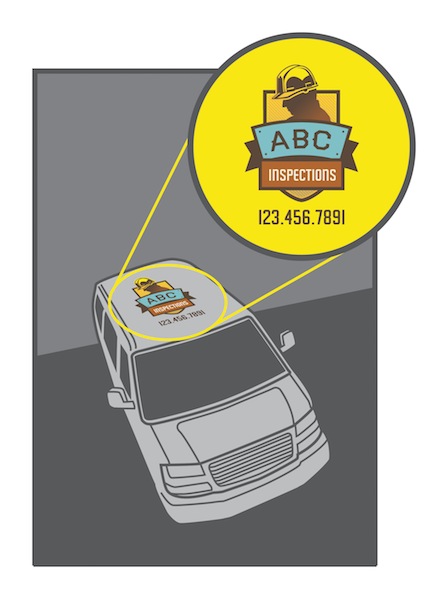Boost Your Inspection Business with Truck Signage

Good vehicle signage promotes your brand. Truck signage is the easiest marketing you can do all day without having to lift a finger. It works while you’re working. The larger your service area, the more people will see it. The smaller your service area, the more people will recognize it and become familiar with it, along with the services it advertises. Truck signage demonstrates that you’re a professional. When you have truck signage, you carry your branding with you to every job, every day.
Truck signs are especially important in jurisdictions that restrict the use of yard signs. Mobile signage goes where you go, and the design options are virtually unlimited.
Some inspectors (especially multi-inspector firms) have their vehicles professionally painted. A newer innovation is custom vinyl applications that are semi-permanent. These are the ultimate marketing tools for dedicated work vehicles, and even for vehicles that do double-duty as a family vehicle. Some may find painting cost-prohibitive, or just enjoy the flexibility of having top-quality magnetic signage to use on different vehicles or upgrades without having to have a new vehicle repainted. With the improved variety and quality of magnetic signage available now, it’s an economical alternative to having your information professionally painted on your truck. Because they’re sturdy, weatherproof, and can be exactly replicated again and again as necessary, magnetic signs are a sound investment in your business marketing that will recoup the expense in drive-by advertising, which is a unique method that all inspectors should take advantage of.
Three Things to Remember: Quality, Quality and Quality

Your sign should include your company name, your logo, your phone number, your web address, and, optionally, your general service area, along with a brief and simple list of the services you offer. Some inspectors may insist on including “Licensed & Insured,” which is another indication of legitimacy and professionalism, especially in states that regulate home inspectors.
However, resist the temptation to include everything but the kitchen sink. Don’t cram a lot of details in your sign, such as your qualifications or an exhaustive list of your ancillary inspection services. Also, unless you have a short and snappy tagline, you may want to omit that, too. You have to make your impression quickly, so, unlike a business brochure, less is more for vehicle signage. For all these considerations that need to strike the right balance between visual appeal and information, it’s best to have your sign professionally designed. Again, InterNACHI’s Design & Print Services can help.
Make the most of your mobile billboard.
Since magnetic signs are affordable and easily transferrable, consider purchasing two signs: one for the driver’s side and one for the passenger side. That effectively doubles your exposure. And don’t neglect the tailgate of your truck. The smaller area may require a specialized sign that’s different from your main sign, but inspectors should take advantage of drivers stopped behind them in traffic who will have ample time to read the signage. This can increase your business’ visibility by more than 60%.
Here are some do’s and don’ts for advertising your business with your work vehicle:
Do:
- Make sure your vehicle is clean inside and out before your first appointment of the day. Many inspectors wash their vehicles first thing in the morning.
- Check every day that your magnetic signage is secure and properly positioned, or you'll give the impression that you're a fly-by-night operation.
- Be a courteous and conservative driver. Don’t speed or tailgate such that other drivers may find your driving aggressive. Since you’ll have your contact information splashed all over your vehicle, you may create negative consequences with your driving that will hurt you personally and professionally—and possibly legally, as well.
- Add advertising to the roof of your vehicle if you work near high-rises or apartment buildings (see below).

Don’t:
- use your vehicle for personal expressions that evoke politics, religion or humor, or identify you with non-professional associations that may have controversial reputations. Avoid (most) bumper stickers, novelty items hanging from the trailer hitch or sitting on your dashboard or attached to your antenna, as well as questionable images on mud flaps, and flags that are not state flags or the U.S. flag. It’s simply not appropriate to display such items at your workplace—or your workplace on wheels—and doing so may create unwanted notions about you and your work ethic and unnecessarily alienate potential clients. Can you afford to say no to new business? Just as we advise our member-inspectors to use discretion and good judgment in choosing their work wardrobe by avoiding t-shirts and hats emblazoned with logos, images, jokes and text that some may find offensive or which may be misunderstood, the same advice holds true for your work vehicle. Err on the conservative side by sticking to business; your no-nonsense approach will be appreciated by your clients.
- neglect to keep the interior (as well as the exterior) of your vehicle clean. You may have to eat three meals a day inside your truck while you juggle a hectic schedule, but police your mess as you go and keep your vehicle tidy. Your clients may notice your messy vehicle and, fairly or not, they will likely form opinions about you and your work habits based on both your appearance and that of your vehicle. It’s unavoidable because it’s human nature, so do what you can to make a good impression throughout the day.
Remember that in everything you do in your workday, you are representing your business, so make the most of it by marketing wherever you go and invest in truck signage. You’ll be surprised at how effective it can be.
Download your free copy of SLEEP WELL: A Home Inspector’s Guide to Managing Risk.
BizVelop: Free Business Development Tool for Home Inspectors

